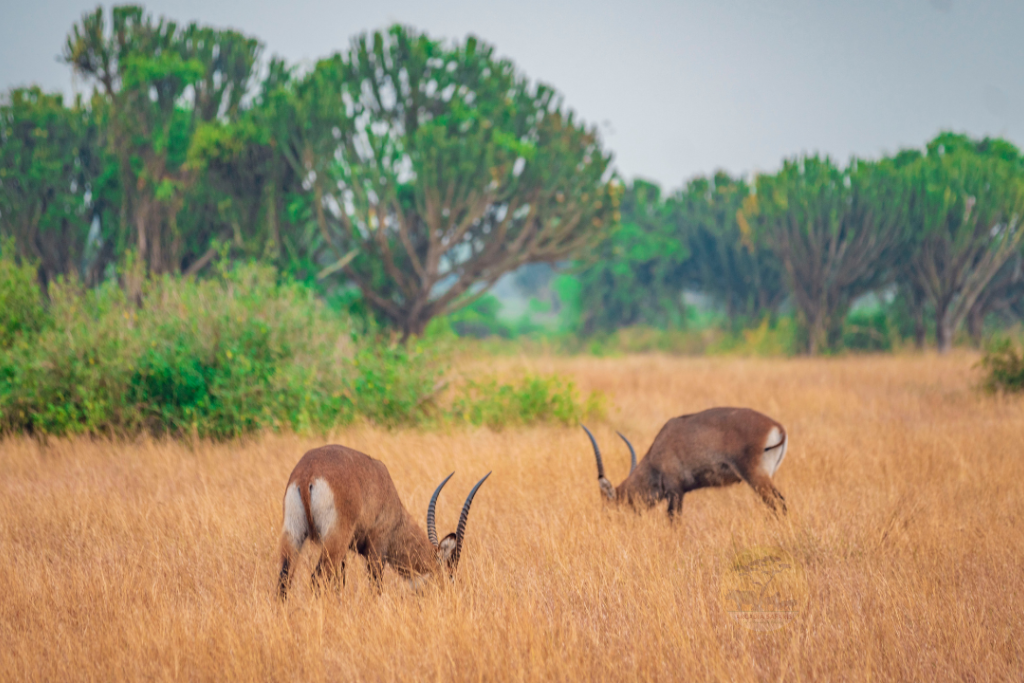Unique Characteristics, Behaviour, and Conservation of Waterbucks in Uganda
Waterbuck (Kobus ellipsiprymnus defassa) in Uganda. Popularly known as the “Pearl of Africa,” Uganda has great diversity in wildlife, which includes one very striking and interesting species, the waterbuck (Kobus ellipsiprymnus defassa). The waterbucks are antelopes occurring in wet areas and have adapted to a semi-aquatic life. These can be found in several national parks and game reserves in Uganda, adding to the country’s appeal as one of the prime destinations for fauna lovers.
Physical Characteristics of a Waterbuck.
The waterbuck is strikingly recognizable by its shaggy coat, which varies in color from grayish-brown to reddish-brown. Perhaps one of the more distinctive features is the typical white ring encircling their rump, hence the derivation of their name. Both males and females have long, forward-curving horns; those of the males are larger and longer.
The shaggy coat provides them with effective protection against parasites, while their peculiar coloration offers them camouflage in the natural environment. All these adaptations make them fit for the savannas, grasslands, and wetland areas they occupy. The animal obtains the name “waterbuck” because of its penchant for aquatic environments. It is a talented swimmer that easily crosses bodies of water.
Habitat and Distribution
The waterbuck is widely distributed in sub-Saharan Africa, although a sizeable population of them thrive within Uganda’s boundaries. They have adapted to habitats varying from grasslands and savannas to areas around rivers and lakes. Ideally, it occurs within Ugandan national parks, like that of Murchison Falls National Park to Queen Elizabeth National Park.
It is also consequential for their anti-predator strategy to have them near water. The waterbucks are good swimmers, and they defend in the water during attacks by predators such as lions and hyenas.
Behavior and Social Structure of a Waterbuck.
Waterbuck are territorial animals, with a hierarchical social behavior. Adults of this species are best known for their long horns, which they defend to ensure that each animal has his territory where he can attract females. They make use of facial glands to elaborate secretions for marking.
The females and their young form herds, divided under a strict hierarchy headed by a dominant male. Such herds serve as protection against predators, while the hierarchical system within the herds minimizes confusion and reduces friction. Waterbucks do a lot of grazing, and a huge percentage of their diet consists of grass, although they will eat leaves and aquatic vegetation.
Feeding Habits of a Waterbuck
Herbivorous waterbucks feed on nearly all types of grasses, shrubs, and aquatic vegetation. Since they are adapted to both grazing and browsing modes, this enables them to exploit a wide range of food sources that are available to them. The close proximity of water bodies means a constant supply of fresh vegetation, among other reasons that account for the general health and vitality of a waterbuck.
Lifespan of a Waterbuck.
In the wild, waterbucks live approximately for 10 to 15 years. Nonetheless, predation, quality of habitat, and diseases determine their ages. In captivity, waterbucks could live a little longer since some of the threats found in their natural habitat are minimal or do not exist.
Conservation Status and Threats.
Currently listed as a species of “Least Concern” by the IUCN, localized threats and habitat loss may be affecting waterbuck populations. Some threats for local waterbuck in Uganda include human-wildlife conflict, poaching, and changing land use.
Of course, establishment and maintenance of national parks, anti-poaching activities, and educative community programs about wildlife conservation go a long way in helping to ensure the survival of waterbuck populations. Ecotourism and sports hunting, in turn-especially if done sensitively-assist in their protection by preserving habitats and raising awareness of the need to protect such unique and charismatic antelopes.
Conclusion on Waterbuck in Uganda.
These waterbucks in Uganda add to the rich tapestry of biodiversity that makes the country a haven for any wildlife enthusiast. Their unique features, behavior, and challenges faced make them important in continued conservation efforts. Through understanding and appreciation, we can thus work toward ensuring that future generations get to witness the beauty of waterbucks in the wild, contributing to the preservation of Uganda’s natural heritage.













